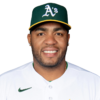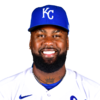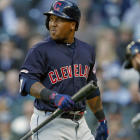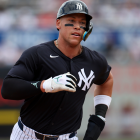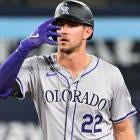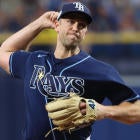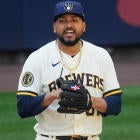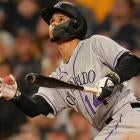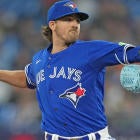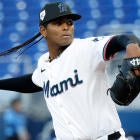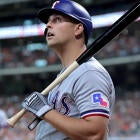For more Fantasy baseball insights, and to keep up with all the latest news, roster trends and more throughout the season, subscribe to Fantasy Baseball Today now on iTunes, Stitcher or Spotify. You can find us on YouTube now, with full episodes and clips available every Monday through Friday.
We should probably talk about Jose Ramirez, right?
It's been a while, and people are concerned. What's "a while?" Well, it's not just that he's hitting .152 (12 for 79) with a .464 OPS through the first 3 1/2 weeks of 2019. There was also the final six weeks of last season, during which he hit .166 (24 for 145) with a .597 OPS. And even this spring, against watered down competition with less-than-fully-incorporated arsenals, he hit just .231 (12 for 52) with a .646 OPS.
So that's 276 at-bats — the last 276 we've seen from Ramirez at any level — in which he has hit just .174.
It'd be concerning enough if he was some trendy late-round sleeper who so many were so desperate to believe in, but Ramirez was the consensus third overall pick, presumed to be the one player in the entire draft pool who might contend with Mike Trout and Mookie Betts for five-category dominance.
Egad, man.
But wait, this is 2019. We have more sophisticated ways to evaluate a player than pure production. Shouldn't there be something under the hood to explain Ramirez's precipitous decline?
Well, it's not a case of him forgetting how to connect with a baseball. His strikeout rate has remained low throughout, with this year's 14.6 percent mark ranking 28th among qualifying batters — a good sign. But when the same was true during last year's miserable stretch, the argument wears thin. What he does with contact also matters. There is such a thing as a low-BABIP hitter, after all.
Where contact failed Ramirez last year was on breaking balls — specifically, curveballs and sliders — which few hitters will have good numbers against. And it's worth pointing out that his .220 batting average on curveballs and .161 batting average on sliders were outside the norm for him. But nonetheless, they happened and were widely credited for last year's bumpy finish.
So what about this year? So far, he's 2 for 7 (.286) against curveballs and 4 for 11 (.364) against sliders. Obviously, the sample is microscopic and suggests nothing about how he'll perform against those pitches going forward, but it does show that they're not responsible for him hitting .150 now.
No, the fastball — a regular old four-seamer — is to blame. He's 1 for 39 against them. The one hit was a home run, which means he has a .000 BABIP on fastballs this year. Meanwhile, his line-drive rate on fastballs is actually better than his career mark, and his exit velocity is as it normally is.
So not only is he making contact on the most common pitch in baseball, but it's hard contact, on a line, the kind that most often results in hits. And yet he has none, not a one, on anything that has landed in the field of play.
That's some inconceivably contradictory data.
I don't know how the issue with the breaking balls will play out. Maybe last year was the new norm. Maybe he'll revert to earlier standards. But there's no reason the results should be as poor as they are against fastballs. There's no evidence of his bat slowing down.
He's going to get better — maybe not as good as he was last year, but good enough for you to attempt to buy low on him. If you need a reminder of how things can turn around for a player, you need look no further than Ramirez himself, who began last year 2 for 33. This slump has persisted longer than that one did, but when it turned around, it was as quick as flipping a light switch.
If you wait for clearer signs of optimism, like a mini hot streak or whatever, you're going to be too late. The Ramirez owner has an awful lot invested in him and will be on guard against doing anything stupid. Only now, because of a confluence of statistical oddities, might you be able to convince him it's stupid not to move Ramirez.
This is an important, oft-overlooked element of the buy-low scenario: There has to be a convincing case why a player is bad. Maybe you could dupe a less seasoned Fantasy GM into dumping a Noah Syndergaard, Anthony Rizzo or Starling Marte for nickels on the dollar, but most, even if they have some feelings of unease, will demand a full return or something close to it, not wanting to be taken for a fool. And what makes a buy-low worth it is the low part.
Ramirez is the rare early-round pick for whom initial worries may have escalated to full-on panic, making him a tremendous buy-low opportunity at this early stage of the season.
Here are some others for whom a Fantasy GM might not extend the usual patience.
Why you could get him: There are slow starts, and there are fighteningly slow starts — ones that are made all the more real when the player is coming off a poor second half (.245 with a .760 OPS). Plus, the Brewers still have Eric Thames, a 31-homer guy in 2017, who has begun to steal starts against right-handed pitchers.
Why you should want him: The 2018 Jesus Aguilar didn't come out of nowhere. He hit .265 with 16 homers and a an .837 OPS in about half a season's at-bats two years ago. A new opportunity opened for him last year, and he met it with numbers that Thames and his 35 percent strikeout rate are unlikely to deliver. Aguilar's own strikeout rate is down this year, and his line-drive rate is up. His hitting coach says his timing is just a little off, and his manager, the man who makes out the lineup, says of Aguilar's bat, "I feel like that's a pretty safe place to be confident." The Brewers are riding the hot hand right now, but Aguilar should reclaim full-time duties once he's back to himself.
Cost should be: next to nothing
Why you could get him: People like that derpy Scott White called Matt Carpenter a bust candidate prior to the season, and it looks like it's happening.
Why you should want him: The reality is that Carpenter's batted ball profile is still perfectly tailored for stud production, like most every other year. It shows an elite line-drive rate, an elite fly-ball and an elite hard-hit rate, which together should make for a big power yield without compromising too much in batting average. It just ... hasn't yet. Health will always concern for the 33-year-old, but performance doesn't appear to be at this stage of the game. And by now, the cost may have fallen to the point of mitigating whatever risk remains.
Cost should be: moderate
Why you could get him: Yu Darvish was a disaster in eight starts last year before getting shut down with an elbow injury that ultimately required season-ending surgery, so he needed to hit the ground running this year to regain the confidence of Fantasy players. Instead, he has delivered an inflated walk total while struggling to meet his past velocity.
Why you should want him: The velocity has significantly improved over his past two starts, even peaking at 99 mph a few times two turns ago, and the whiff rate has risen along with it. The control appears to be the last piece of the puzzle for a pitcher who was probably rusty after so much time away. He has a long enough track record of success, consistently rating among the game's elites thanks to his ability to miss bats that he deserves the benefit of the doubt as long as the stuff appears up to snuff, which it does now.
Cost should be: minimal
Why you could get him: Jose Leclerc's past control issues were the main reason he slipped in drafts despite having mostly elite ratios last year, so the fact he's up to seven walks in eight innings now, having issued four in his latest meltdown Sunday, seems to have confirmed our worst fears. How much longer can he hold onto the role after giving up seven earned runs in his past 3 2/3 innings?
Why you should want him: The Rangers have been steadfast in their support of Leclerc as the closer, which the cynic might say is because they're in a rebuild year and have already committed to him financially, but manager Chris Woodward suggested after Leclerc's last outing that something else may be at work here.
"They have to have something on him, because he's not getting the chase on those borderline pitches that he normally does with his changeup," Woodward said. "We thought something was going on before, that teams had something on him as far as tipping his pitches. I believe that, because guys are dead on his fastball and not swinging at his changeup. You saw the results last year, when you don't know it's coming."
The bigger tip-off than the walks is the drop in swinging strike rate, which has been significant despite no change in velocity. A 15 mph difference in the fastball and changeup should make hitters uncomfortable, and it hasn't. Once Woodward and company pinpoint the problem, the turnaround should be immediate.
Cost should be: minimal
Why you could get him: Buster Posey was showing clear signs of decline before having hip surgery last year and has come back offering next to nothing at the plate. And hey look, his strikeout rate is up.
Why you should want him: OK, but it'd still be a terrific strikeout rate for mere mortals and not one of the best contact hitters of his generation. The rest of Posey's batted ball profile looks pretty much the same as always, complete with a high line-drive rate and all-fields approach, so it's fair to assume he has had some bad luck so far. He may not be a threat for even 15 home runs anymore, much less 20, but the playing time alone gives Posey such an advantage among catchers that even just modest production will make him a difference-maker at the position.
Cost should be: minimal
Why you could get him: Franmil Reyes was more of a preseason curiosity than a sure thing, having made a strong impression over the final two months last year but failing to secure an everyday role this spring.
Why you should want him: An everyday role was always a long shot for Reyes, given the Padres' surplus of outfielders, but even amid his struggles this year, his playing time has only continued to increase, probably because the Padres recognize he has the 15th-best expected wOBA in baseball — a stat that, among full-timers, is led by Mike Trout, Cody Bellinger, Gary Sanchez, Joey Gallo, Christian Yelich, Anthony Rendon and J.D. Martinez. The difference between Reyes' actual wOBA and xwOBA is the largest among players with at least 40 plate appearances, a testament to both his quality of contact and the fact he's making enough contact to get the most out of it.
Cost should be: next to nothing
Why you could get him: Like most every other Red Sox pitcher, Eduardo Rodriguez got off to a miserable start this year, and it's not like he was a sure thing coming in, having delivered a sub-4.00 ERA for the first time in three years last year. In only one of his four starts this year has he gone the minimum required for a quality start.
Why you should want him: His past two starts have been his best two, and his swinging strike rate is way up this year, ranking him alongside some of the best pitchers in the game. Despite being mostly a two-pitcher, he had established himself as a pretty good source of strikeouts over the past couple years, but his continued development of a slider, sometimes classified as a cutter, may be pushing him to new heights this year. He's throwing it more than ever and getting more whiffs with it, which in turn has made his four-seamer and changeup more effective. It's obviously a small sample, especially since the first two starts are difficult to reconcile with the last two, but it's intriguing enough to make him worth a flier.
Cost should be: next to nothing
Why you could get him: Chris Sale's velocity is way down, his strikeouts are down, and he has gotten pummeled in every start but one. The Red Sox have been less than forthright about the details surrounding last year's shoulder injury and hardly let him pitch this spring. There may not be a player whose early-season struggles have been dissected and debated so publicly, which only lends credence to them.
Why you should want him: His velocity was down before he cranked it up again in his last start, which should have been enough to allay our worst fears that he's pitching through injury or has simply "lost it." His slider and overall command still aren't up to speed, probably because of his limited work this spring, but now that we know he can still sling it, it seems like only a matter of time until he's back to normal. His poor results last time out may be a blessing if they grant you one last opportunity to buy low on a consistently and historically dominant pitcher.
Cost should be: fairly high, but not elite
Why you could get him: Corey Seager is coming off Tommy John surgery and struggled before succumbing to it last year, so the memory of him as an elite shortstop isn't fresh on anyone's mind. Besides, his past successes were predicated on a high BABIP, and even now, his .323 mark doesn't suggest bad luck.
Why you should want him: Seager always had a high BABIP because he profiles as a high-BABIP hitter, his line-drive rate consistently ranking among the highest in the game, and even now it's where we're used to seeing it. The fly-ball rate is up, which may be dragging down the BABIP some but should also lead to more home runs if it continues. So far, he has focused on hitting the ball to the opposite field, which hasn't helped with the power production, but it's a pretty good indication that the process is right even if it hasn't led to great results yet. Meanwhile, the strikeout rate is low and the walk rate high, so all in all, there's a strong foundation for stud production here.
Cost should be: moderate
Why you could get him: Voit's draft candidacy was built on a timely power surge late last season, and now the chickens have seemingly come home to roost. Seeing as he had to compete for a job this spring, it's only a matter of time before the Yankees replace him.
Why you should want him: Yeah, he had to compete a job ... with Greg Bird, who was again a complete disaster at the dish and again suffered what sounds like a long-term injury, a torn plantar fascia. It was probably the least significant of the Yankees' injuries, too, and while Giancarlo Stanton and Gary Sanchez are close to returning from the IL, Aaron Judge may be sidelined for the next couple months. So between first base and DH, Voit's playing time is virtually assured, especially since the Yankees continue to show faith in his bat by batting him second, third or fourth almost every day.
And you know why? His 30.8 percent line-drive rate would have ranked third in the league last year. His swing is built more for average and power, which puts his low BABIP in perspective, and yet he's strong enough to hit the ball out of the park when he does elevate it. The strikeout rate isn't any worse than last year, and he continues to walk at high rate. With playing-time assurances in a park well suited for his talents, the upside remains high.
Cost should be: minimal







